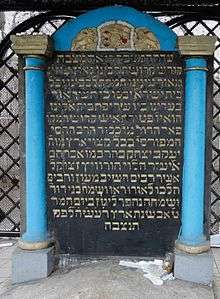Yaakov Yitzchak of Lublin
| Yaakov Yitzchak of Lublin | |
|---|---|
| Seer of Lublin | |
 Tombstone | |
| Full name | Yaakov Yitzchak Horowitz |
| Main work | Torat HaChozeh MiLublin |
| Born | 1745 |
| Died | August 15, 1815 |
| Buried | Lublin |
| Father | Rabbi Avraham Eliezer Halevi Horowitz |
| Mother | Matil, daughter of Rabbi Yaakov Koppel of Lukow |
| Children | Rabbi Tzvi Halevi Horowitz, Rabbi Israel Halevi Horowitz, Rabbi Yosef Halevi Horowitz, Rabbi Avraham Halevi |
Jacob Isaac Horowitz Hebrew: יעקב יצחק הורוביץ, known as The Seer of Lublin" Hebrew: החוזה מלובלין, ha-Chozeh MiLublin; c. 1745 - August 15, 1815) was a Hasidic rebbe from Poland.
A leading figure in the early Hasidic movement, he became known as the "seer" or "visionary" due to his purported ability to gaze across great distance by supernatural means. He was a disciple of the Maggid of Mezritch. He continued his studies under Rabbi Shmelke of Nilkolsburg and Rabbi Elimelech of Lizhensk. He lived for a while in Lantzut before moving to Lublin.
After Yaakov Yitzchak moved to Lublin, thousands of Hasidim flocked to learn from him. Among his disciples were such Hasidic luminaries as the Yid Hakodesh ("The Holy Jew"), Rabbi Simcha Bunim of Peshischa, Rabbi Meir of Apta, Rabbi David of Lelov, the Yismach Moshe, Rabbi Tzvi Elimelech of Dinov, Rabbi Naftali Zvi of Ropshitz, the Ma'or Vashemesh, and Sar Shalom of Belz. The Seer of Lublin also gained a reputation as a miracle-worker who could accomplish the tikkun, or repair of the soul, of those who sought his assistance and guidance. During his stay in Lublin, Yaakov Yitzchak was opposed by a prominent rabbi, Rabbi Ezriel Horowitz.
Yaakov Yitzchak was a descendant of Isaiah Horowitz (Hebrew: ישעיה הלוי הורוביץ), also known as the Shelah ha-Kadosh (Hebrew: של"ה הקדוש), a prominent Levite rabbi and mystic, and his maternal grandfather, Rabbi Yaakov Koppel Likover, also a prominent rabbi, a scholar, and a contemporary of the Ba'al Shem Tov.
He was injured in a fall from a window on Simchat Torah, and died almost a year later on Tisha B'av [1] from injuries relating to this fall. He is buried at Old Jewish Cemetery, Lublin
Works
His writings are contained in four books:
- Divrei Emet
- Zot Zikaron
- Zikaron Zot
- Zikaron Tov
In a compilation of these works, entitled Torat HaChozeh MiLublin, his commentaries are arranged alphabetically according to topics and according to the weekly Torah portion.
References
- ↑ 'Codex Judaica' M.Kantor, p.261
- Dynner, Glenn (2006). Men of Silk: The Hasidic Conquest of Polish Jewish Society. Oxford University Press. ISBN 9781429438346.